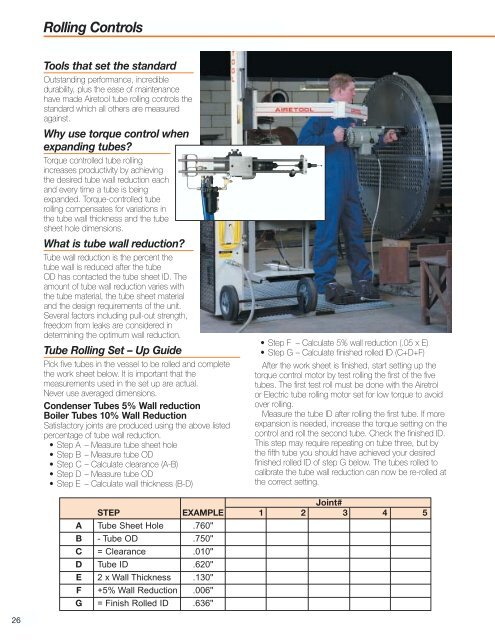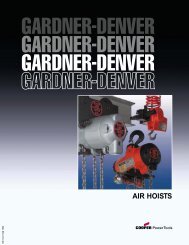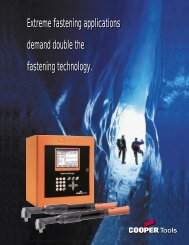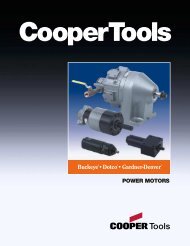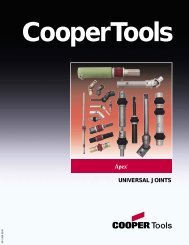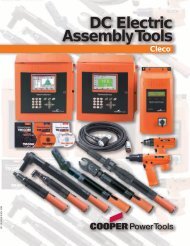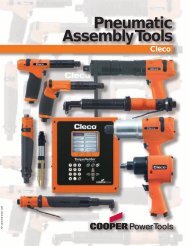Airetool Tube Cleaner and Expanders Catalog - Tecno Italia s.r.l
Airetool Tube Cleaner and Expanders Catalog - Tecno Italia s.r.l
Airetool Tube Cleaner and Expanders Catalog - Tecno Italia s.r.l
Create successful ePaper yourself
Turn your PDF publications into a flip-book with our unique Google optimized e-Paper software.
26<br />
Rolling Controls<br />
Tools that set the st<strong>and</strong>ard<br />
Outst<strong>and</strong>ing performance, incredible<br />
durability, plus the ease of maintenance<br />
have made <strong>Airetool</strong> tube rolling controls the<br />
st<strong>and</strong>ard which all others are measured<br />
against.<br />
Why use torque control when<br />
exp<strong>and</strong>ing tubes?<br />
Torque controlled tube rolling<br />
increases productivity by achieving<br />
the desired tube wall reduction each<br />
<strong>and</strong> every time a tube is being<br />
exp<strong>and</strong>ed. Torque-controlled tube<br />
rolling compensates for variations in<br />
the tube wall thickness <strong>and</strong> the tube<br />
sheet hole dimensions.<br />
What is tube wall reduction?<br />
<strong>Tube</strong> wall reduction is the percent the<br />
tube wall is reduced after the tube<br />
OD has contacted the tube sheet ID. The<br />
amount of tube wall reduction varies with<br />
the tube material, the tube sheet material<br />
<strong>and</strong> the design requirements of the unit.<br />
Several factors including pull-out strength,<br />
freedom from leaks are considered in<br />
determining the optimum wall reduction.<br />
<strong>Tube</strong> Rolling Set – Up Guide<br />
Pick five tubes in the vessel to be rolled <strong>and</strong> complete<br />
the work sheet below. It is important that the<br />
measurements used in the set up are actual.<br />
Never use averaged dimensions.<br />
Condenser <strong>Tube</strong>s 5% Wall reduction<br />
Boiler <strong>Tube</strong>s 10% Wall Reduction<br />
Satisfactory joints are produced using the above listed<br />
percentage of tube wall reduction.<br />
• Step A – Measure tube sheet hole<br />
• Step B – Measure tube OD<br />
• Step C – Calculate clearance (A-B)<br />
• Step D – Measure tube OD<br />
• Step E – Calculate wall thickness (B-D)<br />
• Step F – Calculate 5% wall reduction (.05 x E)<br />
• Step G – Calculate finished rolled ID (C+D+F)<br />
After the work sheet is finished, start setting up the<br />
torque control motor by test rolling the first of the five<br />
tubes. The first test roll must be done with the Airetrol<br />
or Electric tube rolling motor set for low torque to avoid<br />
over rolling.<br />
Measure the tube ID after rolling the first tube. If more<br />
expansion is needed, increase the torque setting on the<br />
control <strong>and</strong> roll the second tube. Check the finished ID.<br />
This step may require repeating on tube three, but by<br />
the fifth tube you should have achieved your desired<br />
finished rolled ID of step G below. The tubes rolled to<br />
calibrate the tube wall reduction can now be re-rolled at<br />
the correct setting.<br />
Joint#<br />
STEP EXAMPLE 1 2 3 4 5<br />
A <strong>Tube</strong> Sheet Hole .760"<br />
B - <strong>Tube</strong> OD .750"<br />
C = Clearance .010"<br />
D <strong>Tube</strong> ID .620"<br />
E 2 x Wall Thickness .130"<br />
F +5% Wall Reduction .006"<br />
G = Finish Rolled ID .636"


